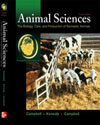
Animal Disease and the Health of Humans |  |
Chapter Summary| Even before recorded history people probably compared diseases of humans with those of animals. However, it has been only relatively recently that epidemiological links between diseases of humans and animals have been revealed. In this chapter an attempt has been made to give a panoramic view of the relation of animal health to public health. A discussion of selected arthropod-borne diseases was also included. Others will be discussed in Chapter 23.
It is possible that most infectious and parasitic diseases of humans originated in animals. The constant challenge of nature to animal health often is also a challenge to the health of people. Several zoonoses (anthrax, plague, rabies, and bovine tuberculosis) are nearly equally harmful to humans and animals. Others (brucellosis, Q fever, and hydatidosis) cause more serious illness in people than in animals. A third group (foot-and-mouth disease, pasteurellosis, and pseudorabies) is less harmful to humans but serious in animals. More than 200 diseases can be transmitted from animals to people, and occasionally vice versa. An understanding of their modes of transmission and control enables humans to associate safely with animals and to utilize the products and services that they provide for humanity.
The universal insidiousness of the infections and infestations in the wide and somber spectrum of animal parasitism alone constitutes a major concern and challenge to modern agriculture and veterinary medicine. The diseases of humans and animals, and those common to both, constitute a serious impediment to the increases in production that are so vitally necessary to the world of today and tomorrow. An estimated 1.6 billion pounds of animal protein, which might be used to improve human nutrition, are lost each year as a result of animal diseases. The value of this meat in the marketplace is unrealized and the labor and capital invested in herds and flocks lost to disease are wasted. As world food needs increase it becomes imperative for humans to exercise improved control over animal health, which will greatly reduce morbidity and mortality losses of farm animals and greatly increase quantities of animal foods useful to humanity. Based on Food and Agriculture Organization of the United Nations estimates, "a 50 percent reduction of losses from animal diseases in the developing countries, which is a realistic goal, would result in a 25 percent increase in animal protein."
|
|
|